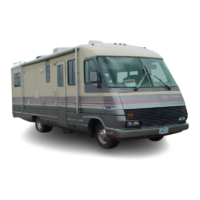13.
Be
sure
the
tank
is
securely
festened
in
its
mounting
rack before each trip.
14.
If
you do
not
have
the
special
tools
and train-
ing necessary. do
not
attempt
to
repair
LP
gas
system
components.
15.
Always
think
safety.
SYSTEM COMPONENTS
Hoses
and
Fittings
The hoses used in your
LPG
system are UL or
eGA
listed. and are
rated
to
withstandma!ly
times
the
pressures encountered
in
the
system.
Although
they
are
designed
for
efficient
and troublefree use,
they
can deteriorate
from
the
effects
of
the
sun and
im-
purities
in
the
air. The average life
of
LP
hoses is
two
·to
three
years. Consequently,
check
the
hoses
for
weather
checking or
other
signs
of
deterioration every
time
you have
the
gas
tank
filled
or
serviced. Protect
the
hoses and
other
parts
of
the
system from sunlight
whenever
possible.
When
you replace hoses, be sure
.
that
replacements are properly rated and approved
for
RV
use.
LP
Gas Regulator
The
regulator
is
the
heart
of
the
LP
gas system.
It
works
continuously
and requires
more
care and at-
tention
than
any
other
part
of
the
system.
Its main
job
is
to
reduce the high and varying
. pressure
of
the
gas
from
the
tank
to
a low, consis-
tent
pressure
to
serve
the
appliances in
the
motor
home.
Normal
tank
pressure can rang'e from
250
psi
to
7 psi
depending
on
the
outside t!'!mperature. The
regulator
smooths
out
these wide variations and sup-
plies your gas appliances
with
a
steady
6.35
ounces,
or
11
inches
water
column
pressure.
It
does this smoothing in
two
stages. The first stage
reduces
the
high
pressure
to
about
10-13 psi. This
allows
the
second
stage
to
be
much
more
efficient
and
accurate
in
controlling
the
pressure
to
the
ap-
pliances. This
two-stage
reduction also helps reduce
the
likelihood
of
freeze-up
or
pilot'outage.
Because
the
regulator is
constantly
"breathing"
it
is
equipped
with
a vent.
When
the
diaphragm inside
the
regulator
moves
up
and
down,
air is
drawn
into
or expelled
from
the
chamber
through
this vent.
If
_ excess pressure builds
up
in
the
regulator, a relief
mechanism
allows
it
to
escape
through
the vent.
It
is
therefore
very
important
thatthe
vent
is clean and
free
of
obstruction.
Clogging
from corrosion, dirt, in-
sect
nests,
or
other
debris is
the
most
common
cause
of
regulator
malfunction.
Even a small piece
of
material
that
finds
its
way
into
the
inlet can result
in
improper
pressures in
the
system and possible
damage
to
or
failure
of
components.
The regulator
is
mounted
so
that
the
vent
is facing
downward
and
is protected
from
freezing road spray and other foreign
matter
by
a
water-resistant
cover.
Be
sure
the
cover
is on at all
times.
If
the
vent
does
become
clogged,
it
can
be
cleaned
with
a
toothbrush.
34
WARNING: DO NOT ATIEMPT
TO
ADJUST
THE
REGULATOR.
IT
HAS BEEN. PRESET BY THE
REGULATOR
MANUFACTURER." IF
ANY
AD-
JUSTMENT IS REQUIRED.
IT
MUST
BE
MADE
BY
A QUALIFIED
LPG
SERVICE TECHNICIAN
USING SPECIAL
EQUIPMENT.
USING LP GAS SYSTEM
AT
LOW
TEMPERATURES
Your gas system
will
function
at
low
temperatures,
provided
the
system
components
are
kept
at
a
temperature
above
the
vapor
point
of
the
LP gas.
NOTE: Butane vaporizes
at
about
32
° F and
propane
vaporizes at
about
-4.0°F. Choose a
type
of
LP
gas
which
has a boiling
point
approximately
40°F
lower
than any temperature you
expect
to
encounter.
Ask
your
LP
gas supplier
or
your
motor
home
dealer
for
information on
product
blends available in
your
area.
LP
gas systems can and
do
freeze
up
in
very
cold
weather.
It
is a
common
misconception
that
the
regulator or
the
gas
itself
freezes. Actually,
it
is
the
moisture
or
water
vapor
that
gets
trapped
in
the
system
or
absorbed
by
the
gas
that
freezes and
causes the problem. This
ice
can
build
up
and
par-
tially or totally
block
the
gas supply.
Where does the
water
come from? From a
variety
of sources: The gas can
be
saturated
with
water
when
it
comes
out
of
the
gas
plant
or
refinery
unless
care
is taken
to
see
that
it
is
thoroughly
dehydrated;
the
gas can abSorb·
water
while
it
is
transported
if
the
tank cars contain water;
the
gas
storage
tanks
may
have
water
in
them
because
moist
air
has
been
trap-
ped in
the
tank because a valve
was
left
open.
There
are
a number
of
things
you
can
do
to
pre-
vent freeze up:
1.
Be
sure the gas tank
is
totally
moisture·free
before
it
is
filled.
2.
Be
sure the
tank
is
not
overfilled. This is also
a safety consideration.

